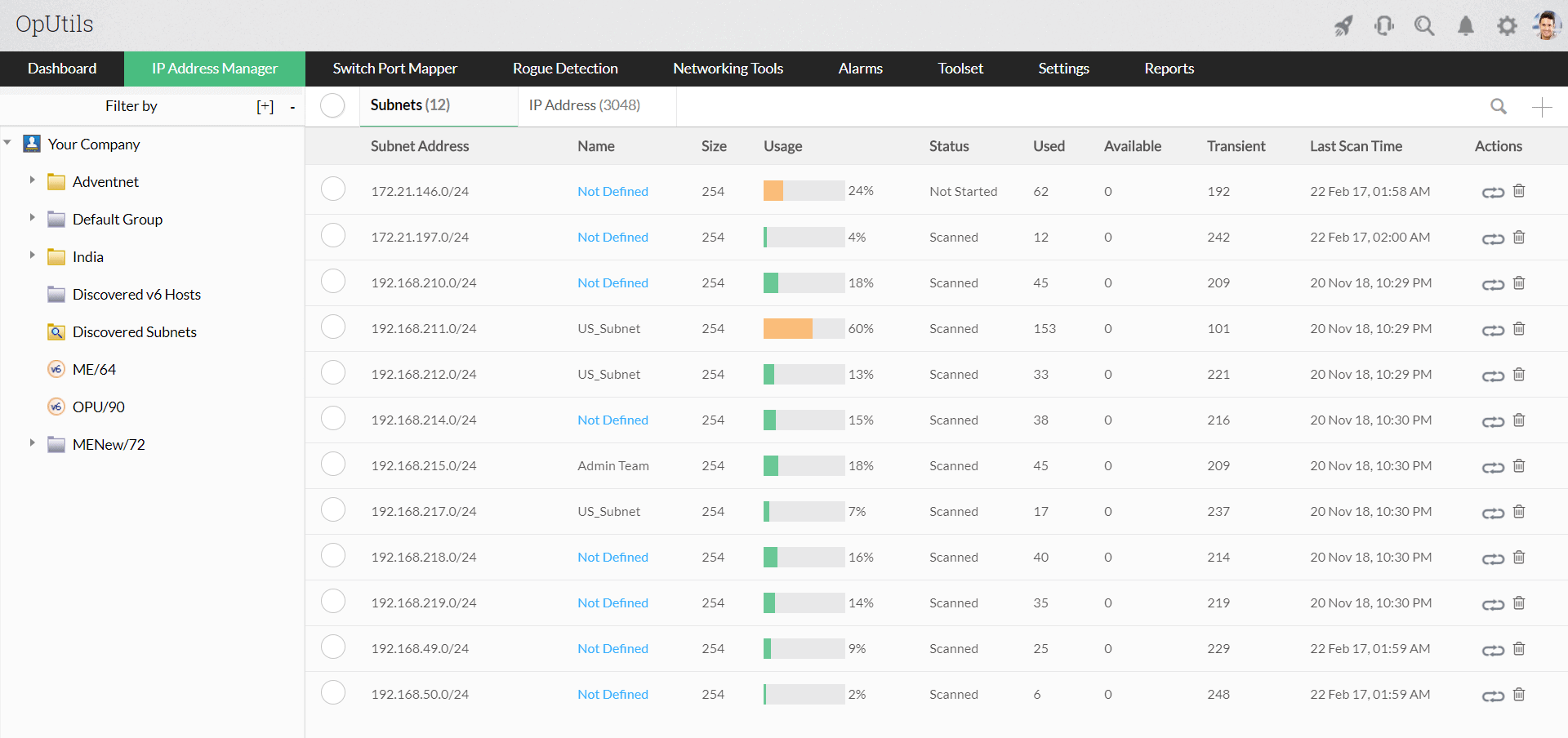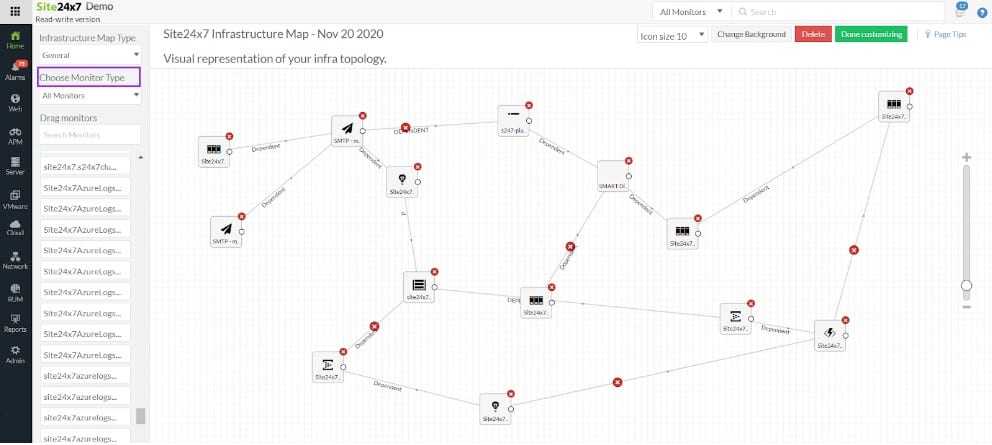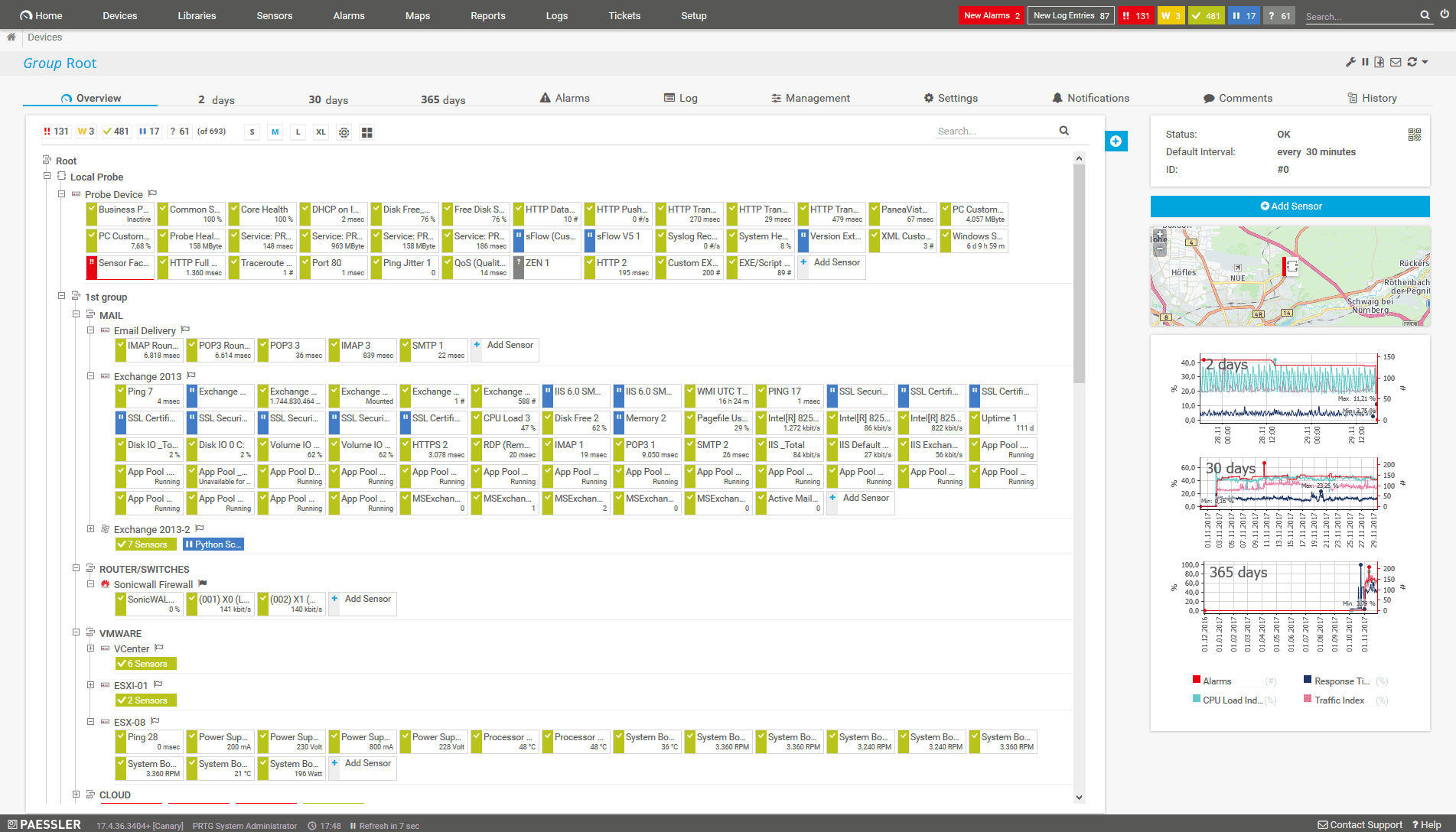We may earn a commission if you make a purchase through the links on our website.
The Best IP Monitoring Software to Keep Critical Servers Monitored & Online
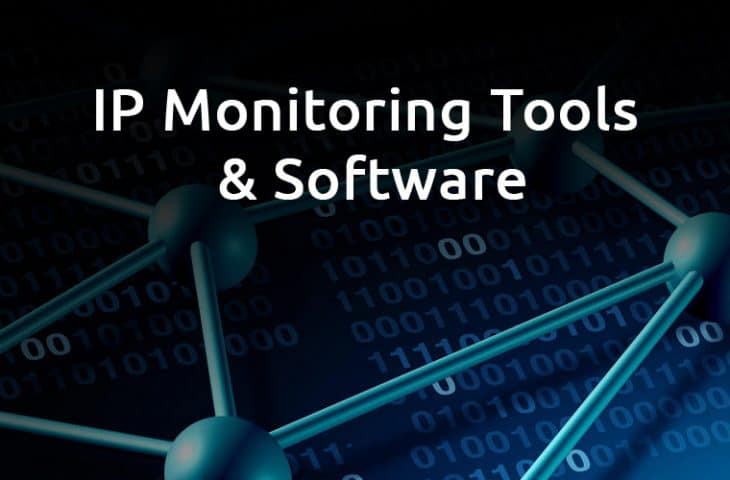
UPDATED: January 17, 2025
Having a reliable network has become a critical factor for all and any businesses. A small service downtime or a traffic bottleneck can represent a big revenue loss. Networking experts and industry leaders are aiming for networks that maintain a 99.99% availability to avoid any kind of loss. A big piece of the puzzle in maintaining that kind of availability is to implement IP monitors and alerting systems. Using a centralized IP monitoring software ensures that all components are up and running smoothly. The core function of these tools is to keep an eye on critical IP-connected devices and services in real time.
Here is our list of the best IP monitoring tools:
- ManageEngine OpUtils – EDITOR'S CHOICE This bundle deals with network addressing issues and includes an IP address manager, a switch port mapper, and a logical port scanner. Offered for Windows Server, Linux, and AWS. Download a 30-day free trial.
- Site24x7 – FREE TRIAL This cloud-based platform includes network IP monitoring and server performance monitoring as part of its full-stack observability functions. Get a 30-day free trial.
- Paessler PRTG – FREE TRIAL This flexible package lets you decide which monitoring tool to turn on and its base system includes a network scanner that gives you a full list of all devices with their IP addresses and statuses. It also dares up a network topology map. Available for Windows Server and as a SaaS platform. Get a 30-day free trial.
- PA Server Monitor While primarily focused on server monitoring, this package includes a Ping utility that you can set to run periodically and check the availability of all devices. Installs on Windows Server.
- VisualPulse This is a continuous Ping sweep that discovers all devices on your network and provides response times. Runs on Windows.
- Nagios Core A free full-stack monitoring package that includes a network discovery routine. Available for Linux.
- Zabbix A free monitoring package for networks, servers, and applications that includes network discovery with IP address monitoring. Runs on Linux, cloud platforms, or Docker.
On the basic level, these tools will automatically send pings to check response and raise alarms and notifications when a failure occurs. Having this access to this information allows you to act quickly and avoid problems before they occur.
Some benefits of monitoring your IP network include:
- Keep server svailability close to 99.99%.
- Improve server performance and predict trends by analyzing statistics.
- Keep an eye on your server anywhere and from any device with online web-interface monitoring services.
- Send real-time alerts or activate a script when a certain threshold level is reached.
Our methodology for selecting IP monitoring software
We reviewed the market for the best IP monitoring software and analyzed tools based on the following criteria:
- Know your key objectives for network needs like server uptime, and real-time alerts.
- Consider scalability, compatibility, usability, customization, and your budget as well.
- Gather and go through industry reports, software reviews, and user feedback.
- Look for features like network visualization, alerting system, integration with existing systems and third-party tools.
- Go for trial versions in real-world environments, ease of use, and reliability.
- Consider add-ons, license fees, maintenance costs, subscription charges, and hidden fees if any.
The Best IP Monitoring tools
The following list of IP monitoring software will help you to keep an eye on all critical servers. We included their extra features, their official download site, and the pricing plan if it was publicly available – as some of these software manufacturers tend to not post them on their sites.
1. ManageEngine OpUtils – FREE TRIAL
ManageEngine OpUtils is an IP address manager that will constantly poll the network, discovering all IP addresses in use. The tool also produces a report that you can you to reconcile IP address pools in your DHCP server and identify abandoned addresses to return to the pool for reuse. You can also use the list to check the hostname allocations in your DNS server.
Key Features:
- IP Address Management: Simplifies the process of managing IP addresses with advanced tracking, ensuring efficient IP utilization and preventing conflicts.
- Switch Port Mapping: Offers detailed switch port views, pinpointing what devices are connected to each port and their configuration.
- Network Monitoring: Immediate monitoring of the network performance; latencies and congestions are spotted.
- Alerting System: Notifies managers of the network issue that can be responded to immediately.
Why do we recommend it?
We recommend ManageEngine OpUtils because 96% of users appreciate its effective ITSM solutions and valuable insights. OpUtils excels at scanning TCP ports and SNMP-enabled devices, retrieving comprehensive IP address details, system information, and MIB object identifier (OID) data. Its advanced IP scanning capabilities for both IPv4 and IPv6 subnets allow for accurate identification of available and used IP addresses. This functionality ensures efficient network management and enhanced visibility, making OpUtils an essential tool for network administrators.
The switch port mapper in the OpUtils package scans your network switches and documents each interface, noting which device is connected to each port. The logical port scanner examines each endpoint, looking at the TCP and UDP ports, and identifying which are open.
If you don’t need a full IP address manager, you could opt for the free edition of OpUtils as it just provides an IP address scanner. You don’t get the switch port mapper or the port scanner with that version. Both the free and paid versions install on Windows Server or Linux and you can get OpUtils as a service on AWS Marketplace. ManageEngine offers a free trail of the Professional edition and if you don’t buy the tool at the end of that period, your installation switches over to the Free edition.
Who is it recommended for?
Network engineers should use ManageEngine OpUtils to enhance their network management capabilities. This tool complements existing management systems by offering troubleshooting and real-time monitoring features. With over 20 tools, OpUtils simplifies tasks like managing switch ports, tracking IP addresses, detecting rogue devices, monitoring bandwidth usage, and ensuring the availability of critical devices. It also facilitates backing up Cisco configuration files, making it a comprehensive solution for efficient and effective network monitoring and management.
Pros:
- User-Friendly Interface: Intuitive and straightforward forward, making it useful also to those with little experience.
- Complete IP Management: Provides robust tools for managing and monitoring IP addresses, reducing conflicts, and improving network efficiency.
- Real-Time Monitoring: Tracking real-time network performance gives the company a chance to identify and solve any problem swiftly.
- Customizable Alerts: Allows for highly customizable alert settings to ensure timely notifications for potential network problems.
Cons:
- Limited Free Trial Features: Some of the priorities are restricted to the demo version. These limitations could be the reason why you will not be able to fully assess the tool.
Get a 30-day free trial.
EDITOR'S CHOICE
ManageEngine OpUtils is our top pick for an IP monitoring package because it offers a comprehensive, easy-to-use solution for managing and monitoring IP addresses across large and dynamic networks. With the increasing complexity of modern networks, ensuring that IP addresses are utilized efficiently and securely is vital. OpUtils provides powerful tools to track, manage, and audit IP addresses, enabling network administrators to optimize IP address allocation and prevent conflicts. One of OpUtils’ core features is its IP Address Manager (IPAM), which allows IT teams to efficiently manage and allocate IP addresses within their network. The IPAM tool helps organizations keep track of which addresses are in use and which are available. It provides real-time monitoring of IP address usage trends. This helps prevent issues like IP address exhaustion and reduces manual tracking efforts. OpUtils includes features like subnet discovery and IP conflict detection, ensuring that network administrators are immediately alerted if any issues arise. The tool also offers network device monitoring, providing real-time insights into device status, availability, and performance. By monitoring device connectivity and IP addresses, the tool enables IT teams to proactively identify potential network issues before they impact performance.
Download: Get a 30-day free trial
Official Site: https://www.manageengine.com/products/oputils/download.html
OS: Windows Server, Linux, and AWS
2. Site24x7 – FREE TRIAL
Site24x7 implements IP monitoring as part of its network monitoring module. The package includes a network discovery service that identifies all devices connected to the network, such as switches, routers, firewalls, and endpoints. The package also automatically tracks the activities on each server that it discovers.
Key Features:
- Network device discovery that records all IP addresses currently in use
- Device availability checks that include tests for endpoints
- Automatically creates and maintains a hardware inventory and network topology map
This tool provides real-time monitoring of network devices and servers, ensuring that critical IP addresses are accessible and operating efficiently. Site24x7 tracks key metrics such as response time, uptime, and latency for each IP, allowing administrators to quickly identify any issues that might disrupt network performance. This proactive monitoring ensures businesses can address potential problems before they lead to significant downtime or connectivity disruptions.
Site24x7’s IP monitoring tool offers customizable alerts to notify teams immediately when an IP address goes down or experiences performance degradation.
Pros:
- Provides constant monitoring of IP addresses, ensuring immediate awareness of any connectivity issues or performance degradation
- Allows users to set personalized alerts for various IP performance thresholds
- Tracks essential metrics such as uptime, latency, and response time for each IP address
- Generates detailed historical reports on IP performance
- Built-in diagnostic tools such as ping and traceroute
Cons:
- Some users have reported slight delays in alert notifications
Site24x7 is a cloud-based platform that can monitor any network anywhere through the installation of a local agent. It is also able to test connections between sites and cloud systems. You can assess the package with a 30-day free trial.
3. Paessler PRTG – FREE TRIAL
Paessler PRTG is an IP/network scanner and monitoring software to keep an eye on critical servers. its unified monitoring is used not only for network devices but also for bandwidth, servers, apps, virtual environments, IoT and more.
Key Features:
- Complete Monitoring: Covers all aspects of network infrastructure, including servers, bandwidth, and applications, for a holistic view of network health.
- User-Friendly Dashboard: Brings out an interactive interface using customizable dashboards, which makes the process of visualizing and analyzing network data straightforward.
- Flexible Alerts: Creates a bunch of threshold conditions and alarms, so as to keep you informed of any changes which may impact critically.
- Scalable Solution: Capable of scaling to monitor small and large networks, accommodating the needs of growing businesses.
Why do we recommend it?
We recommend Paessler PRTG for IP monitoring because it is the best network activity monitoring to ensure your servers are always up and running. It checks for website availability, crashes, bandwidth, database, and various other network factors. It includes using flow technology, SNMP, packet sniffing, and many other advanced techniques to perform first-class network monitoring. You can always sit back and relax because this tool will make sure everything across the network is ok by keeping a constant check and reacting immediately in case of detection of high-priority issues.
On the basic level, PRTG automatically pings an IP or range of IPs and begins to monitor the status of the associated devices. The tool also uses SNMP sensors to provide a quick overview of the network and summary of the traffic going in and out. The centralized dashboard uses different colors to organize the statues of the network elements. You’ll see green when everything is running smooth and jump into the red when there is a failure which also activates various actions, such as notifications, alerts or remediation scripts.
PRTG apps let you check your network remotely, anywhere and from any device. Its online monitoring platform lets you control the entire network from a single web interface.
Who is it recommended for?
Paessler PRTG is widely used and recommended for network admins and network engineers who need to deal with network performance and other data. It provides a complete picture of network activity to stay updated with the status of devices and networks. It keeps experts updated with all minor details like hogging bandwidth, network latency, and more. It sends customized reports and notifications by SMS or email about the entire network activity.
Pros:
- All-in-One Solution: Ensure network smoothness with a wide scan of all the network components and develop the best scenario of network health.
- Highly Scalable: Suitable for both small and large networks, growing with the needs of your organization.
- Flexible Alerting: Provides various alert configuring possibilities so that the users can be alerted when there is a problem emanating.
- Easy Setup: Quick and straightforward installation process, with minimal configuration required to start monitoring.
Cons:
- Resource Intensive: May be expensive for users, especially on the bigger networks as they may suffer under heavy load in the system.
PRTG is free for up to 100 monitoring sensors. To figure out your network requirements you can register for a 30-day free trial.
4. PA Server Monitor
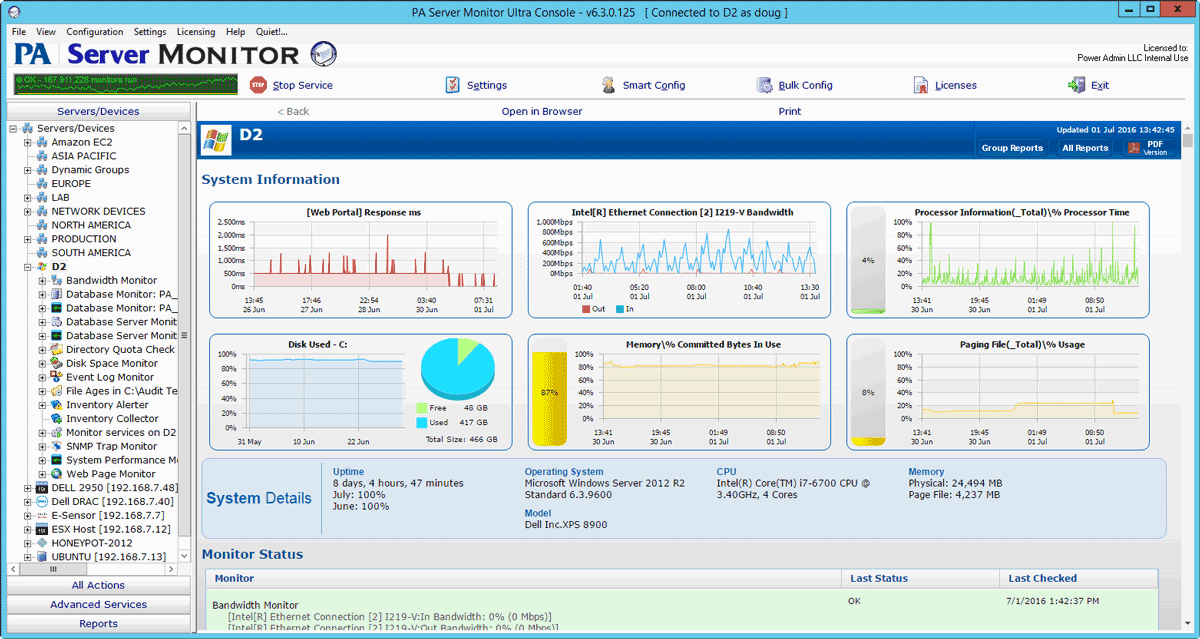
Server Monitor by Power Admin (PA) offers an agentless server and network monitoring tool. The tool can monitor the performance of Windows, Linux, and different vendor network devices.
Key Features:
- Extensive Server Monitoring: Keeps track of the servers by monitoring their performance, hardware failures, and software bugs to be assured of server wellness.
- Automated Reports: Strikes off the details from reports and produces them automatically, refining the machine-described server performance issues among all.
- Real-Time Alerts: Through e-mail, SMS, or any other methods, administrators would be notified promptly of any problems on the server critical part.
- Remote Management: Allows remote monitoring and management of servers, ensuring that you can maintain server health from anywhere.
Why do we recommend it?
We recommend PA Server Monitor as it is built by the IT admin itself to fulfill complex IT monitoring needs. This tool is easy to install and use, it understands IT problems very well to know where the issue lies. It comes with a sleek design and powerful features such as CPU, memory usage, SNMP, traps, alerting, and network device monitoring. It supports agentless monitoring and can be used for remote distributed locations. You can use this tool for Windows and Linux servers.
The tool doesn’t rely on agents to gather information. Instead, it sends automatic pings to check the health of network elements. PA Server Monitor does not only monitor network resources, it also monitors disk space, memory, disk, SNMP + traps, web page content, services, event logs, processes, etc. And if you are on the go, you can still monitor all your devices through remote monitoring using secure port 443, or HTTPS web-interface.
Administrators like PA because it is designed with security in mind. The software does not keep any data in the cloud; it keeps everything on the servers.
Who is it recommended for?
PA Server Monitor is recommended for IT administrators, network managers, and system administrators as it specializes in running server uptime and securing the critical servers and network devices of the organizations. It is ideal for enterprises of all sizes that require extensive monitoring, real-time warnings, detailed reporting, and automated maintenance chores. Sectors such as banking, healthcare, and education, where server dependability and data integrity are critical, would benefit most from using PA Server Monitor to preserve operational efficiency.
Pros:
- Detailed Server Monitoring: Provides in-depth monitoring of server performance, hardware health, and software status.
- Automated Reporting: Automatically generates detailed reports, saving time and providing valuable insights.
- Remote Access: Allows for remote monitoring and management, offering flexibility for administrators.
- Real-Time Alerts: Delivers real-time notifications of server issues, ensuring quick response times.
Cons:
- Complex Configuration: Initial setup and configuration can be complex, requiring a steep learning curve for new users.
PA offers a free 30-day full-featured trial. The software can be purchased on four different licenses. Choose what matches your needs from the following types, Lite, Pro, Ultra, and Corporate Ultra.
5. VisualPulse
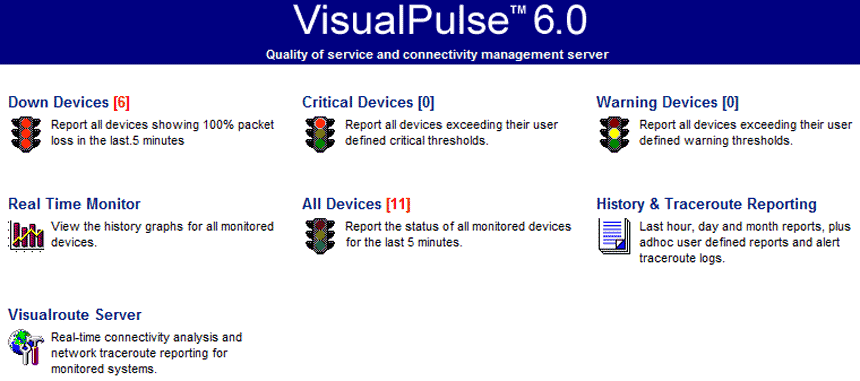
VisualPulse IP Monitor is a real-time IP monitoring software that allows you to check hundreds of devices simultaneously. The tool does not only makes sure that IP addresses are responding, but that they are also performing well.
Key Features:
- Web-Based Monitoring: Utilizes a web interface for monitoring network performance, making it accessible from any location with internet access.
- Real-Time Data: Provides real-time data on network latency, packet loss, and response times, helping to identify and resolve issues quickly.
- Historical Reporting: Maintains historical data for trend analysis and long-term performance evaluation.
- Customizable Alerts: Allows setting up specific alert conditions to receive notifications about network performance issues.
Why do we recommend it?
We recommend VisualPulse to ensure all your network devices and services are performing well. It helps users to see real-time feedback by analyzing packet loss, latency, response times, ping response, and much more. The tool continuously monitors hundreds of IP addresses to check their response and performance. VisualPulse gathers effective information and monitors the patterns of network traffic to make you understand how it is performing and create detailed reports accordingly. You can try it for 15 days free to explore its features and understand how it monitors IP and helps you achieve the organization's goals.
To make sure that your network is performing correctly, its browser allows you to access key metrics like ping latency, packet loss, downtime, response time, errors, and even TCP/UDP/SNMP total I/Os. You can define thresholds on these metrics to differentiate devices by how they are responding and get notified when certain threshold is reached. With these data in hand, you can create detailed reports in HTML or XLS and get a better understanding of your network, spot patterns and identify potential failures.
Who is it recommended for?
Network administrators, IT specialists, and technical support teams that need to track and evaluate server availability and network performance will find VisualPulse to be very helpful. By giving professionals access to real-time statistics on packet loss, response times, and network latency, it facilitates the prompt detection and repair of connectivity problems. VisualPulse helps you maintain dependable and effective network infrastructure because of its graphical user interface and extensive reporting features, which help in tracking performance trends and guaranteeing optimal network operations.
Pros:
- Web-Based Access: Accessible from any location with an internet connection, offering flexibility for remote monitoring.
- Real-Time Monitoring: Provides real-time data on network performance, aiding in swift issue resolution.
- Historical Data: Maintains historical performance data for trend analysis and long-term planning.
- Customizable Alerts: Allows users to set specific alert conditions, ensuring timely notifications for network issues.
Cons:
- Limited Scope: Primarily focuses on network performance, lacking broader monitoring capabilities for other IT infrastructure components.
Try VisualPulse completely free for 15 days. Starting at standard edition for license only on 10 elements at $295.00. Find more information on the official price list.
6. Nagios Core
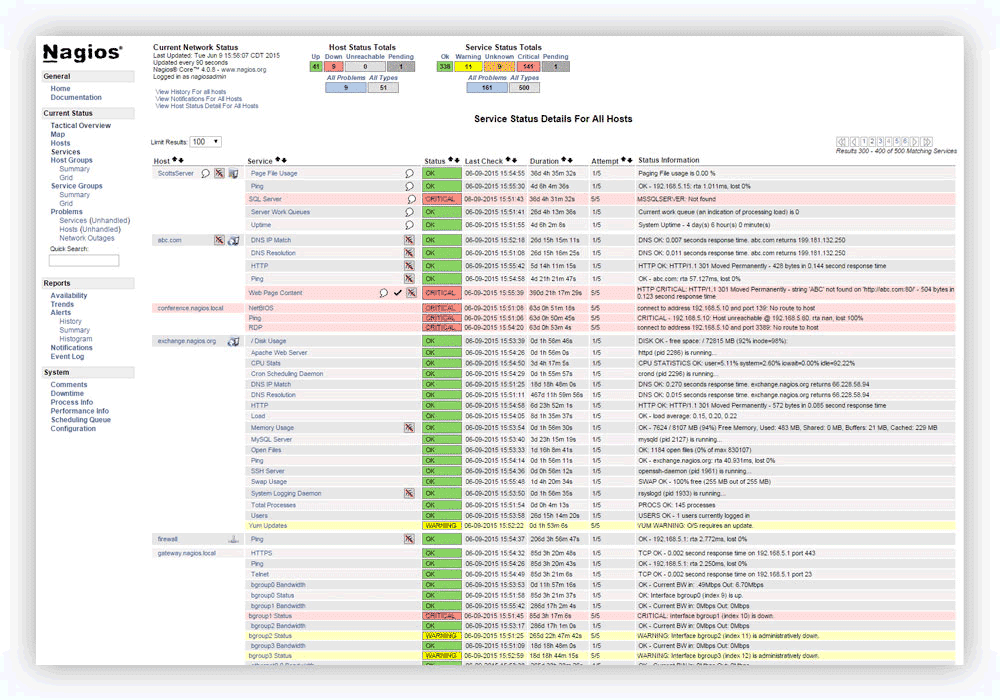
Nagios Core was created with flexibility and scalability in mind. The core feature set can be extended through the use of a thousand different add-ons. This tool was designed to run natively on Linux systems but now it can support Windows as well. Nagios is an industry-standard IT infrastructure monitoring software developer. Nagios created the free and open-source Nagios Core to keep critical servers monitored online.
The software monitors elements by scheduling, handling, processing, and alerting the basic events. This tool does not check performance, send notifications, or processes performance data. These tasks are left in the hands of other Nagios projects.
Key Features:
- Open Source Flexibility: As an open-source tool, it offers high customization and flexibility to tailor the monitoring system to specific needs.
- Extensive Plugin Support: Supports a wide range of plugins to extend its monitoring capabilities across various network components.
- Scalable Architecture: Designed to scale from small to large networks, making it suitable for businesses of all sizes.
- Complete Monitoring: Monitors network services, applications, and server resources to ensure all aspects of the network are covered.
Why do we recommend it?
Nagios Core is a robust, open-source monitoring tool that provides superior network awareness and reliability. It offers advanced alerting and reporting features, delivering granular, packet-level data for comprehensive tracking and analysis. The tool will instantly send alerts and notifications to admins when any thresholds are breached or abnormal network activity arises.
Furthermore, it ensures optimal network performance by generating thorough statistics. the statistics contain bandwidth use by source, IP, or custom combinations using its customizable bandwidth utilization calculator.
Who is it recommended for?
We recommend this tool for network administrators, IT managers, and cybersecurity experts because it is useful to get in-depth network analysis and clarity. It provides extensive statistics and high-level information for in-depth network health analysis, ensuring network monitoring. Users can obtain a unified picture of network traffic and bandwidth, highlighting potential threats. Ensure a secure and well-managed network environment by having instant access to critical NetFlow and sFlow data sources, server system metrics, and the ability to detect network anomalies for rapid diagnosis.
Pros:
- Highly Customizable: Open-source nature allows for extensive customization to meet specific monitoring needs.
- Wide Plugin Support: Supports a vast range of plugins, extending its functionality across various network components.
- Scalability: Designed to scale from small to large networks, making it versatile for different business sizes.
- Strong Community Support: A large and active community provides extensive resources, plugins, and support.
Cons:
- Complex Setup: Initial setup and configuration can be time-consuming and require significant technical expertise.
Get Nagios Core from its official site – open source and free.
7. Zabbix
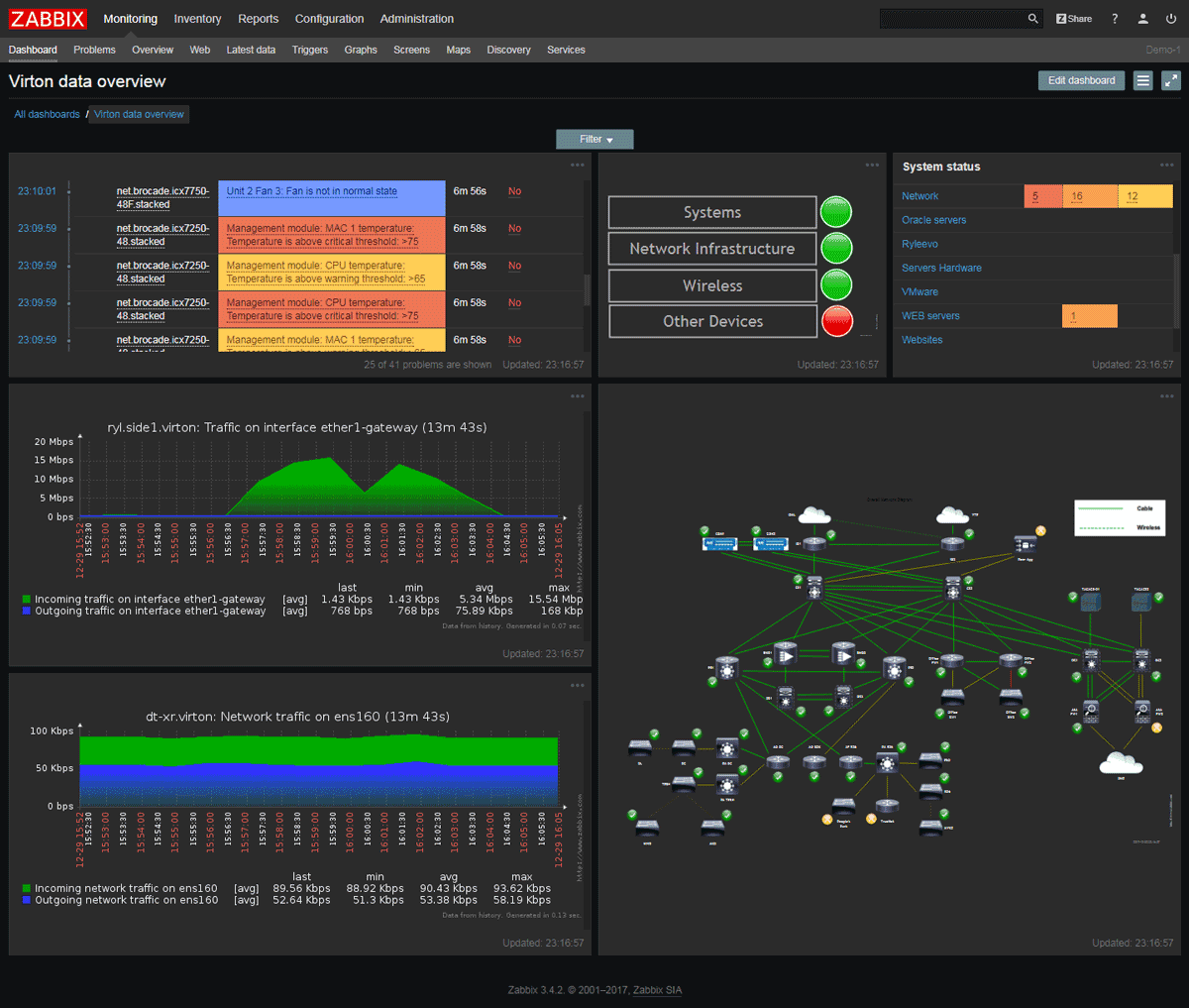
A free and open-source monitoring software, Zabbix is a comprehensive tool for monitoring networks, operating systems, and services. It can help you keep an eye on critical server performance metrics and ongoing incidents.
Key Features:
- Unified Monitoring: Provides a single platform to monitor networks, servers, cloud services, and applications, delivering a comprehensive monitoring solution.
- Highly Customizable: Offers extensive customization options for dashboards, alerts, and reports to meet specific monitoring requirements.
- Advanced Data Collection: Collects data using various methods, including SNMP, IPMI, and custom scripts, ensuring comprehensive data acquisition.
- Real-Time Visualization: Features real-time visualizations of network performance and health, aiding in quick identification and resolution of issues.
Why do we recommend it?
We prefer Zabbix for IP monitoring because of its broad and versatile features. Zabbix enables you to monitor your network's health and performance by collecting SNMP measurements or running Zabbix agents to monitor a number of network parameters. Applying proper templates to network monitoring endpoints allows you to easily gather and analyze network metrics. Zabbix effectively monitors network device performance and status, offering a reliable solution for ensuring optimal network operations.
There is no need to install agents on the monitored hosts. Just allow basic services such as SNMP, ICMP, TCP, SSH, IPMI, or Telnet to send simple checks to verify server availability and responsiveness. If you want extended monitored services, you can install the agent on either UNIX or Windows and monitor metrics such as CPU load, bandwidth, disk space, network and memory utilization, etc.
Who is it recommended for?
Zabbix is a good tool for IP monitoring for network administrators, IT managers, and infrastructure engineers. Zabbix may be used to monitor long-term patterns in bandwidth utilization as well as respond to unforeseen network failures, spikes, packet loss, and ping loss. It provides the capacity to recognize abnormal network activity, detect and dynamically modify expected network metric baseline values, and suppress alerts during device maintenance or upgrades. Zabbix is therefore a vital tool for preserving the performance and stability of networks.
Pros:
- Complete Monitoring: Monitors a wide range of IT infrastructure, including networks, servers, cloud services, and applications.
- High Customizability: Offers extensive customization options for dashboards, alerts, and reports.
- Advanced Data Collection: Supports multiple data collection methods, ensuring thorough monitoring.
- Real-Time Visualizations: Provides real-time visualizations, making it easier to identify and address issues quickly.
Cons:
- Steep Learning Curve: This can be challenging for new users to learn and configure, requiring significant time and effort to master.
Get and install Zabbix from its official site – free and open-source.
Conclusion
There is no good monitoring software that can improve a badly-implemented network. Good IP monitoring practices start with the skills of the Network Admin or Manager. Having a good network plan and design, infrastructure installation, IP addressing scheme, monitoring and operation plan is the real key to a 99.99% available network.
But, there are tools in the admin’s toolbox that can make life much easier.
The IP monitoring tools and software described above are considered the best, and will definitely help the network admin perform a better job. Get more details from their official sites and give them a free download and install to see which one suits your network needs.
